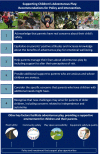Parent perceived barriers and facilitators of children's adventurous play in Britain: a framework analysis
- PMID: 35365107
- PMCID: PMC8976306
- DOI: 10.1186/s12889-022-13019-w
Parent perceived barriers and facilitators of children's adventurous play in Britain: a framework analysis
Abstract
Background: From a public health perspective there is growing interest in children's play, including play involving risk and adventure, in relation to children's physical and mental health. Regarding mental health, it is theorised that adventurous play, where children experience thrilling, exciting emotions, offers important learning opportunities that prepare children for dealing with uncertainty and help prevent anxiety. Despite these benefits, adventurous play has decreased substantially within a generation. Parents have a key role in facilitating or limiting children's opportunities for adventurous play, but research identifying the barriers and facilitators parents perceive in relation to adventurous play is scarce. The present study therefore examined the barriers to and facilitators of adventurous play as perceived by parents of school-aged children in Britain.
Methods: This study analysed data from a subsample of parents in Britain (n = 377) who participated in the nationally representative British Children's Play Survey. Parents responded to two open-ended questions pertaining to the barriers to and facilitators of children's adventurous play. Responses were analysed using a qualitative Framework Analysis, an approach suitable for managing large datasets with specific research questions.
Results: Four framework categories were identified: Social Environment; Physical Environment; Risk of Injury; Child Factors. Social Environment included barriers and facilitators related to parents, family and peers, as well as community and society. Dominant themes within the Social Environment related to perceptions about the certainty of child safety, such as supervision and the safety of society. Beliefs about the benefits of adventurous play for development and well-being were also important in the Social Environment. Physical Environment factors focused on safety and practical issues. Risk of Injury captured concerns about children being injured during play. Child Factors included child attributes, such as play preference, developmental ability and trait-like characteristics.
Conclusions: Improved understanding of what influences parent perceptions of adventurous play can inform public health interventions designed to improve children's opportunities for and engagement in adventurous play, with a view to promote children's physical and mental health.
Keywords: Adventurous play; Barriers; Children; Facilitators; Parents.
© 2022. The Author(s).
Conflict of interest statement
HD is funded by a UKRI Future Leaders Fellowship which also funds RN’s salary. Play England, Play Wales, PlayBoardNI, HAGS and the Association of Play Industries are partners on this fellowship. Outdoor Play and Learning and Learning through Landscapes are collaborating organisations. No direct funding is received from any of these organisations. All other authors declare no conflicts of interest.
Figures


References
-
- Sandseter EBH. Characteristics of risky play. Journal of Adventure Education & Outdoor Learning. 2009;9(1):3–21. doi: 10.1080/14729670802702762. - DOI
-
- Coster D, Gleeve J. Give us a go! Children and young people’s views on play and risk-taking. 2008.
Publication types
MeSH terms
Grants and funding
LinkOut - more resources
Full Text Sources

